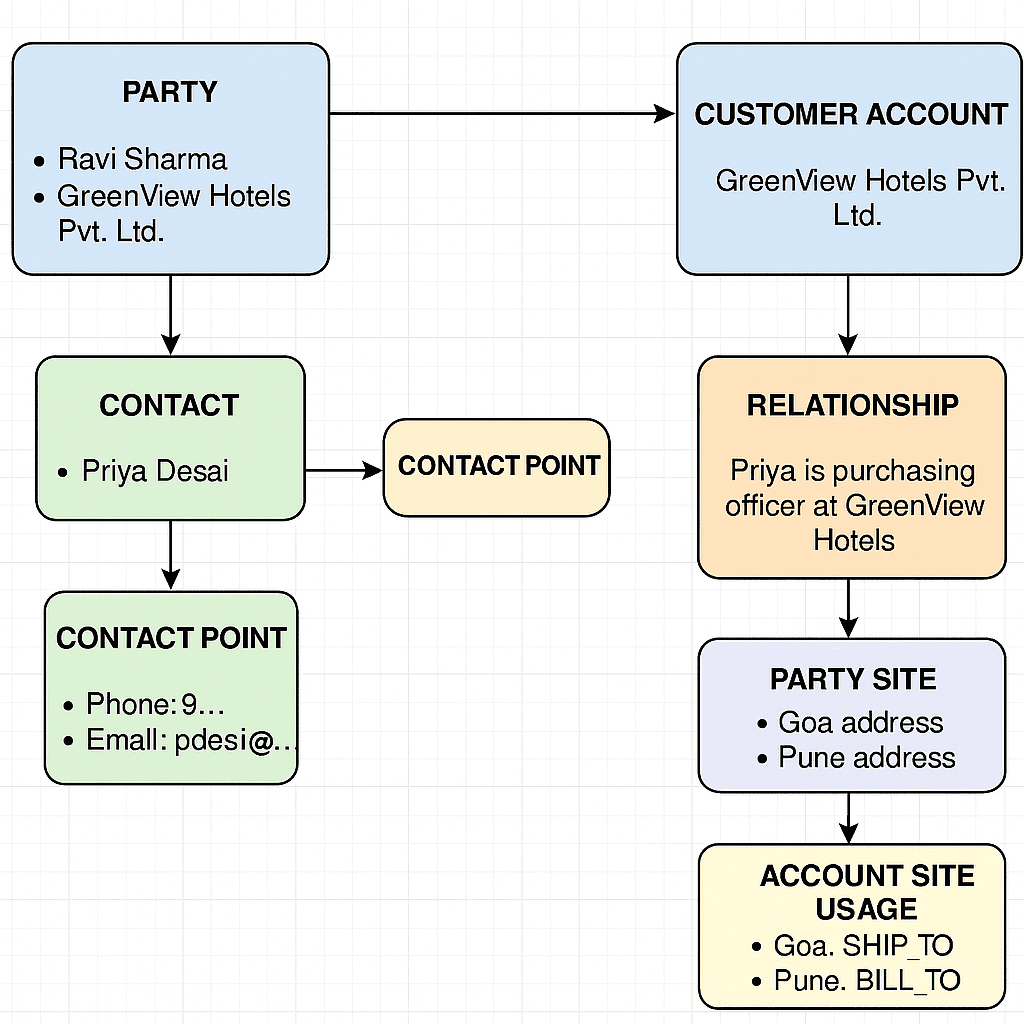
Trading Community Architecture: TCA Guide in Oracle EBS
In today’s business world, clean, centralized data is the foundation of success. Oracle’s Trading Community Architecture (TCA) is the powerful engine within Oracle E-Business Suite (EBS) R12 that makes this possible. You can think of TCA as a master address book and relationship manager for your entire business network.
TCA centralizes and organizes all information about your parties—customers, suppliers, partners, and even employees. This ensures that a single entity, like a customer, has one unified record, no matter where they interact with your business (e.g., sales, billing, shipping). This single source of truth is critical for avoiding errors, streamlining processes, and enabling powerful analytics.
Table of Contents
Understanding the TCA Data Model
TCA Components and Functional Areas
Key HZ Tables in Oracle Apps R12
Business Benefits of TCA Implementation
Best Practices for Configuring TCA
Challenges and How to Overcome Them
The Future of Trading Community Architecture
Key Components of TCA
What is a Party in Trading Community Architecture?
In trading community architechure a party is an entity in the TCA Registry that can enter into business relationships. Party can be divided into mainly three types as given below:
- A Person (e.g., Priya Desai)
- An Organization (e.g., GreenView Hotels)
- A Relationship (e.g., Priya Desai as a contact for GreenView Hotels)
Each party is assigned a unique Registry ID. TCA stores rich information for parties, including names, addresses, contacts, and communication methods. For example, Priya Desai might have a personal phone number, and a different number when acting as GreenView Hotels’s contact.
Party Relationships
Party relationships define how two parties are connected in TCA. Following are the few party types:
- Person-to-Organization (e.g., Priya as an employee of GreenView Hotels)
- Org-to-Org (e.g., Division to Headquarters)
- Person-to-Person (e.g., Legal guardianship)
Relationships are dynamic, reciprocal, and unlimited. They help you model roles, responsibilities, and business linkages within the trading community.
The Trading Community Architecture Object Hierarchy
- Party – The core entity (e.g., “GreenView Hotels”)
- Party Site – A location tied to that Party for a specific use (e.g., mailing address)
- Contact Point – Means of contact like phone or email
- Account – A business relationship such as a customer or supplier account
- Account Site – A party site used in the context of an account (e.g., billing or shipping address)
- Site Use – Describes how an address is used (e.g., Bill-to, Ship-to)
- Location – A geospatial point defined by an address
- Contact – A person connected to a party through employment or business relationship
You can understand this relationship using TCA diagram.
Party vs Account
- A Party can ve created even if no business is done.
- An Account to be created only when there’s a business relationship with the party with your company.
CRM uses the Party layer. ERP uses the Account layer. Together, they form a complete Customer.
Trading Community Architecture Components and Functional Areas
1. Party Management
TCA allows businesses to create, update, and manage a wide array of party data:
- Maintain parent-subsidiary relationships
- Create individuals, organizations, or relationships
- Manage party classifications (e.g., customer vs. vendor)
Data Quality Management:
- Duplicate prevention via Oracle DQM
- Standardization of naming conventions
- Matching rules for new party creation
2. Account Management in Trading Community Architecture
An “Account” in TCA signifies the formal transactional relationship you have with a Party. Interestingly, a single Party can have multiple Accounts representing different facets of your engagement.
Key Functions:
- Creation and management of both customer and supplier accounts, tailored to the specific relationship.
- Establishment of hierarchical account structures, crucial for managing global accounts with numerous operating entities.
Example: A global retailer with separate accounts for each regional division. - Configuration of financial parameters at the account level, including credit limits, payment terms, and preferred billing cycles.
3. Site & Site Use Management in Trading Community Architecture
Party Site: This is a relationship between a location and a party that indicates that a location exists for that party. It stores address information.
Account Site: Links address to specific accounts.
Site Use: Defines how that location is used in transactions.
Primary uses include:
- Bill-To
- Ship-To
- Sold-To
Site data accuracy ensures smooth transaction processing, correct tax jurisdiction, and proper delivery of goods/services.
4. Contact Management
TCA facilitates the management of key contacts at both the overarching Party level and the more specific Account level. Contacts can be associated at both party and account levels. Link contacts to multiple accounts and sites.
Key Capabilities:
- Assign contacts to parties or accounts
- Define contact details and roles
- Share contacts across entities.
5. Trading Community Data Hub (TCDH) [Advanced/Optional]
For organizations grappling with master data residing in disparate systems, TCDH extends the power of TCA. It acts as a central, authoritative repository for consolidating and governing trading partner master data.
TCDH is especially useful for multinational organizations dealing with multi-source data integration.
Key Advantages:
- Single version of customer and supplier truth
- Advanced duplicate detection algorithms
- Seamless integration with legacy systems
Key (Trading Community Architecture) HZ Tables in Oracle Apps R12
TCA data model uses many tables to store the TCA information in structure way. You can understand the overview of the TCA(HZ) Tables in Oracle Receivables.
How TCA Works: The CamPrint India Story

CamPrint India Pvt. Ltd. is a tech retail company based in Bengaluru. They sell cameras and printers in-store and online. They serve both individual buyers and corporate clients like hotels and educational institutes.
Party
One day, a person named Ravi Sharma visited CamPrint’s Mumbai store. He inquired about a Canon EOS camera but didn’t buy. Still, he shared his name and mobile number. CamPrint saved his information.
In Oracle TCA, Ravi became a Party — a person or organization known to the business. He wasn’t yet a customer because no transaction had taken place.
At the same time, GreenView Hotels Pvt. Ltd., a hotel chain from Ahmedabad, contacted CamPrint. They needed electronics for their new hotel in Goa. CamPrint created another Party for GreenView Hotels. Now, two parties existed:
- One for Ravi (person)
- another for GreenView (organization)
Contact
GreenView’s Priya Desai, called on behalf of her company. She introduced herself and shared her email and phone number.
CamPrint created a Contact for her — a person representing the organization.
Contact Point
Priya’s phone number and email address were saved too. These were stored as Contact Points. They are ways to reach the contact — phone, email, fax, etc. Each contact can have multiple contact points.
Relationship
CamPrint also needed to know how Priya was related to GreenView Hotels. She was authorized to negotiate on behalf of her company.
This relationship — Priya is a purchasing officer at GreenView — was saved as a Relationship. This is stored in the HZ_RELATIONSHIPS table.
Relationships can be:
- Person to Organization (Priya to GreenView)
- Organization to Organization (Parent company to branch)
- Person to Person (e.g., family link)
Customer Account
After initial discussions, GreenView placed their first order. They were no longer just a party — they became a Customer.
CamPrint created a Customer Account for them. Now, GreenView had commercial terms, payment history, and credit information attached.
Party Sites
GreenView wanted the printers delivered to their new hotel in Goa. They also wanted invoices sent to their finance team in Pune. CamPrint first created Locations — Goa and Pune addresses.
Then they created Party Sites — links between GreenView and those physical locations.
This tells the system: GreenView is associated with these places.
Customer Account Site
The party sites became Customer Account Sites. These are the shipping and billing points tied to a Customer Account.
So, CamPrint added:
- Goa as a SHIP-TO site
- Pune as a BILL-TO site
Both of these belong to GreenView’s customer account.
Account Site Usage
Each Customer Account Site was tagged with a Usage:
- Goa: SHIP_TO (delivery address)
- Pune: BILL_TO (invoice address)
This is stored as Account Site Usage. It defines the purpose of each address in business transactions.
Back to Ravi – From Party to Customer
A month later, Ravi Sharma came back to buy the Canon EOS R8. Now, CamPrint converted him from a Party to a Customer. They created a Customer Account for him.
His home address in Andheri became a Customer Account Site. He chose to ship it there, and the same address was used for billing.
CamPrint added his email and mobile as Contact Points again. Now linked to both his party and customer account.
TCA in Action
Later, GreenView expanded. They opened new hotels in Jaipur and Ooty.
Each hotel got its own Customer Account. But they were all linked to the main corporate party (GreenView Hotels Ahmedabad).
This parent-child link was stored in HZ_RELATIONSHIPS.
Thanks to Oracle TCA:
- There were no duplicate customer records
- Every address and role was reused where needed
- Support teams always knew whom to call
- Sales teams had a 360-degree view of each client
Business Benefits of Trading Community Architechture Implementation
- Unified party data across modules
- Fewer billing and delivery errors
- Smoother integration with AR, OM, AP, CRM, etc.
- Stronger reporting and compliance
- Faster onboarding for customers and suppliers
- Better audit and data governance
Best Practices for Configuring Trading Community Architecture
1. Strategic Planning
- Begin with business process mapping
- Understand the flow of party data across departments
2. Data Governance
- Define naming conventions and roles for data creation
- Set up approval workflows for changes
3. Leverage Built-In Tools
- Use Oracle’s Data Quality Management (DQM) features
- Standardize address and contact formats
4. TCA APIs
Oracle provides TCA (HZ) APIs to create/update TCA entities. For developers, APIs such as HZ_PARTY_V2PUB and HZ_CUST_ACCOUNT_V2PUB enable:
- Automated party creation
- Integration with third-party CRMs or portals
5. Training and Adoption
- Train end-users on TCA structure
- Provide guidelines for party and account creation
6. Ongoing Data Audits
- Monitor for duplicates and inactive records
- Schedule quarterly data clean-up activities
Challenges and How to Overcome Them
| Challenge | Solution |
|---|---|
| Data Duplication | Implement stringent DQM matching rules, leverage TCDH’s advanced de-duplication processes, and establish clear data entry protocols with built-in duplicate checks. |
| Migration of Legacy Data | Thoroughly cleanse, profile, and map legacy data to the TCA model before loading. Utilize data migration tools and scripts, and perform rigorous data validation post-migration. |
| Lack of User Understanding | Conduct structured and role-based training sessions, provide easily accessible user guides and FAQs, and establish a support system for addressing user queries and issues. |
| Misalignment with Business Needs | Invest time in detailed business process mapping and requirements gathering. Customize party types, site uses, and attributes thoughtfully to accurately reflect your unique business relationships. |
| Integration with External Systems | Strategically utilize TCA APIs for real-time or batch data exchange. Implement robust error handling and monitoring mechanisms for integrations. |
| Managing TCA Customizations | Adhere to Oracle’s best practices for customizations. Thoroughly document all customizations and ensure they are considered during upgrades and patch applications to maintain system stability. |
The Future of Trading Community Architecture
While Trading Community Architecture within Oracle E-Business Suite R12 is a mature and robust framework, the fundamental principles it embodies are more critical than ever in 2025:
- TCA remains foundational and continues to evolve
- Core to Oracle Cloud and Fusion CDM
- Near real-time API integrations
- AI/ML to match and cleanse data
- Centralized and reusable contact points
Even as the technological landscape continues to evolve, TCA remains a critical cornerstone for establishing and maintaining clean, consistent, and actionable master data within the Oracle E-Business Suite R12 ecosystem.
Conclusion
Trading Community Architecture is far more than a static data model within Oracle E-Business Suite R12 – it is the dynamic foundation upon which accurate transactions are built, meaningful trading partner relationships are nurtured, and strategic business decisions are confidently made.
Whether your organization is embarking on a new Oracle R12 implementation or seeking to optimize an existing environment, investing the time and resources to develop a well-designed and actively managed TCA strategy will yield significant long-term benefits in data accuracy, operational efficiency, enhanced scalability, and ultimately, a stronger bottom line.
What’s next for your organization’s TCA journey?
- Conduct a comprehensive health check of your current TCA setup to identify areas for improvement.
- Prioritize training your team on TCA best practices and the importance of data quality.
- Implement robust data governance policies and workflows for ongoing data maintenance.
Glossary
- Party: Any individual, organization, or group that can enter into a business relationship.
- Party Site: A physical address or location associated with a Party.
- Account: The formal business relationship established between your organization and a Party.
- Account Site: A specific address relevant to a particular Account.
- Site Use: The designated function of an Account Site within a transaction (e.g., Bill-to, Ship-to).
TCA Case Study Highlight
A leading global manufacturing client, grappling with significant invoice errors and customer dissatisfaction due to inconsistent address data, achieved a remarkable 30% reduction in invoice disputes and a 15% improvement in on-time delivery rates after a strategic restructuring of their TCA model. This involved standardizing party site definitions, enforcing primary contact assignments at the account level, and implementing automated address validation rules.




Pingback: What is EBS in Oracle? A Complete Guide to Its Power & Benefits
Pingback: TCA HZ Tables in Oracle Apps R12